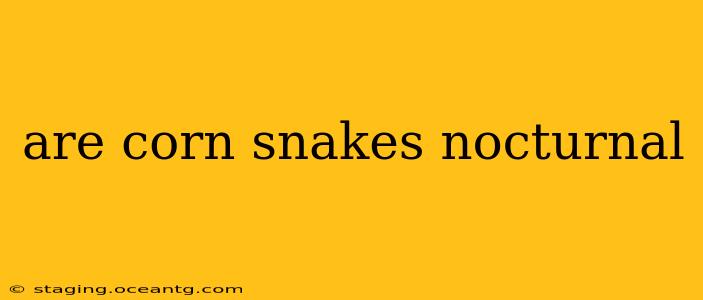Corn snakes, beloved for their docile nature and stunning variety of colors and patterns, are often described as crepuscular rather than strictly nocturnal. Let's delve into their activity patterns and address some common questions surrounding their sleep-wake cycles.
What Does Crepuscular Mean?
Before we dive into corn snake behavior, it's crucial to understand the term "crepuscular." Crepuscular animals are most active during twilight hours – the periods of dawn and dusk. This means they're active when the sun is rising and setting, leveraging the softer light and cooler temperatures. While they can be active at night or during the day, their peak activity falls during these transition periods.
Are Corn Snakes Active at Night?
While primarily crepuscular, corn snakes can be active at night. Their activity level will depend on several factors, including their age, individual personality, and environmental conditions. A younger, more energetic corn snake might be more active at night, while an older snake might prefer longer periods of rest. Similarly, temperature and humidity can influence their activity levels. High temperatures might push them towards nocturnal activity to escape the heat.
What Time of Day Are Corn Snakes Most Active?
As mentioned, corn snakes are most active during twilight hours – dawn and dusk. This is when they are most likely to hunt and explore their environment. However, observing your own corn snake will give you the best understanding of its individual preferences. Keep a log of when it's most active to get a personalized view of its daily rhythm.
Do Corn Snakes Sleep During the Day?
Yes, corn snakes will often sleep during the day, particularly if they are kept in an enclosure with a temperature gradient. They'll typically seek out a warmer basking spot during the day and then become more active during the cooler twilight periods. Providing a suitable hide allows them to feel secure and rest undisturbed.
Why Are My Corn Snakes Active at Different Times?
The timing of your corn snake's activity can vary due to several factors:
- Age: Younger snakes tend to be more active overall, including at night.
- Individual personality: Just like humans, snakes have individual personalities. Some are more naturally nocturnal or diurnal than others.
- Environmental factors: Temperature and humidity significantly influence their activity.
- Feeding schedule: A recently fed snake might be less active as it digests its meal.
How Can I Tell If My Corn Snake Is Healthy Based on Its Activity Level?
Consistent changes in activity level can be a sign of underlying health issues. A usually active snake that suddenly becomes lethargic should prompt a consultation with a veterinarian specializing in reptiles. Similarly, unusual levels of activity might indicate stress or discomfort. Observing your snake’s regular activity patterns is crucial for detecting potential problems early on.
By understanding the crepuscular nature of corn snakes and the factors influencing their activity, you can provide a better environment for your reptile companion and enjoy observing its unique behaviors. Remember that individual variations exist, so careful observation of your specific snake is key to understanding its rhythms and ensuring its well-being.
